MKT1MDP Assignment: Analysis of the Australian Confectionery Industry
VerifiedAdded on 2022/10/19
|9
|1893
|353
Report
AI Summary
This report analyzes the Australian confectionery industry, focusing on market conditions, key players, and growth strategies. It utilizes data from Marketline Advantage and IBISWorld to conduct a PESTEL analysis, examining political, economic, social, technological, environmental, and legal factors influencing the industry. The report also delves into market segmentation and targeting, highlighting the dominance of chocolate and the significance of distribution channels like supermarkets and hypermarkets. Furthermore, it assesses the competitive landscape through a five forces analysis, evaluating the bargaining power of suppliers and buyers, the threat of new entrants and substitutes, and the degree of rivalry. Based on these analyses, the report offers recommendations for manufacturers to enhance manufacturing processes, comply with regulations, and adapt to changing consumer preferences, ultimately aiming to increase sales and generate revenues in the competitive Australian market.
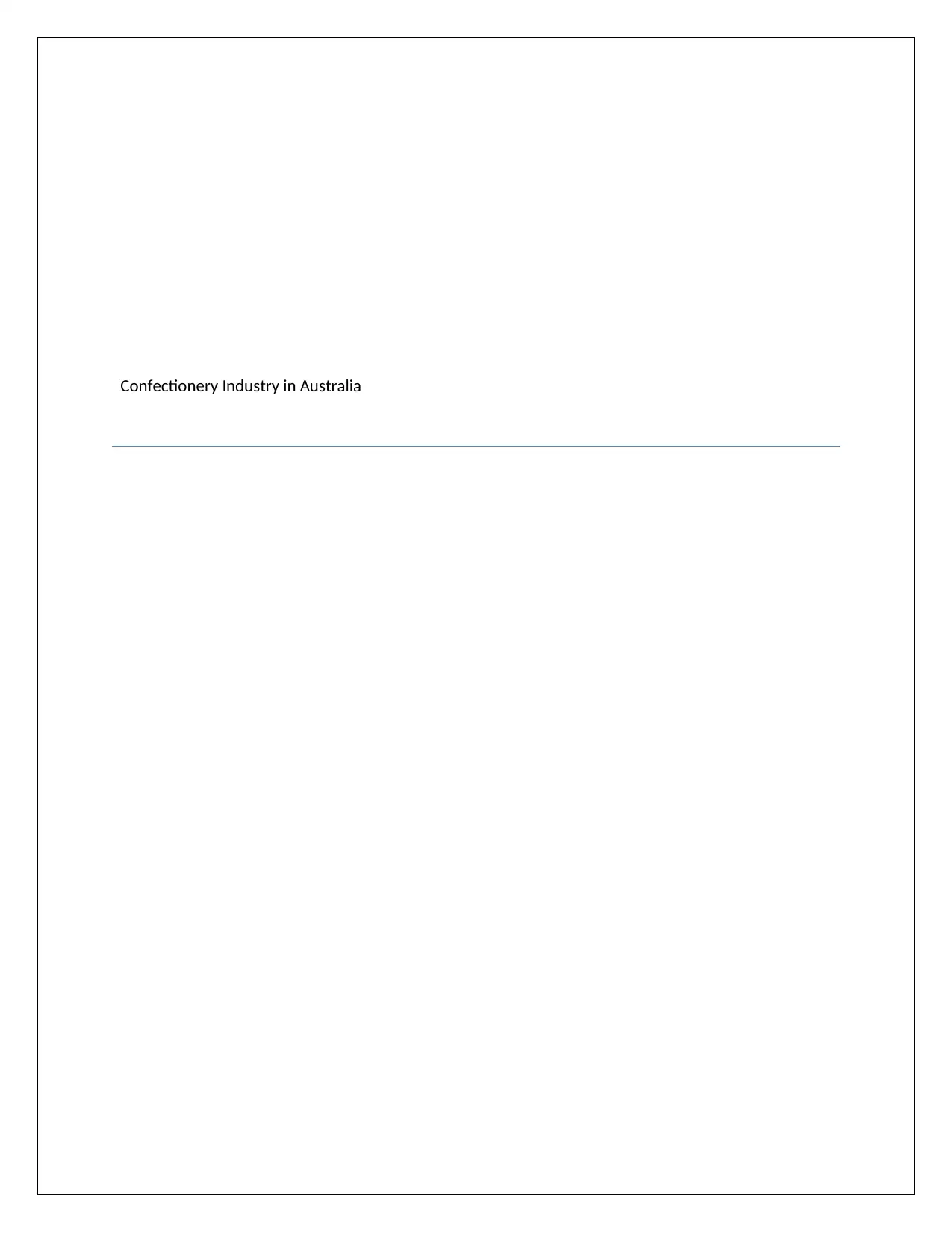
Confectionery Industry in Australia
Paraphrase This Document
Need a fresh take? Get an instant paraphrase of this document with our AI Paraphraser
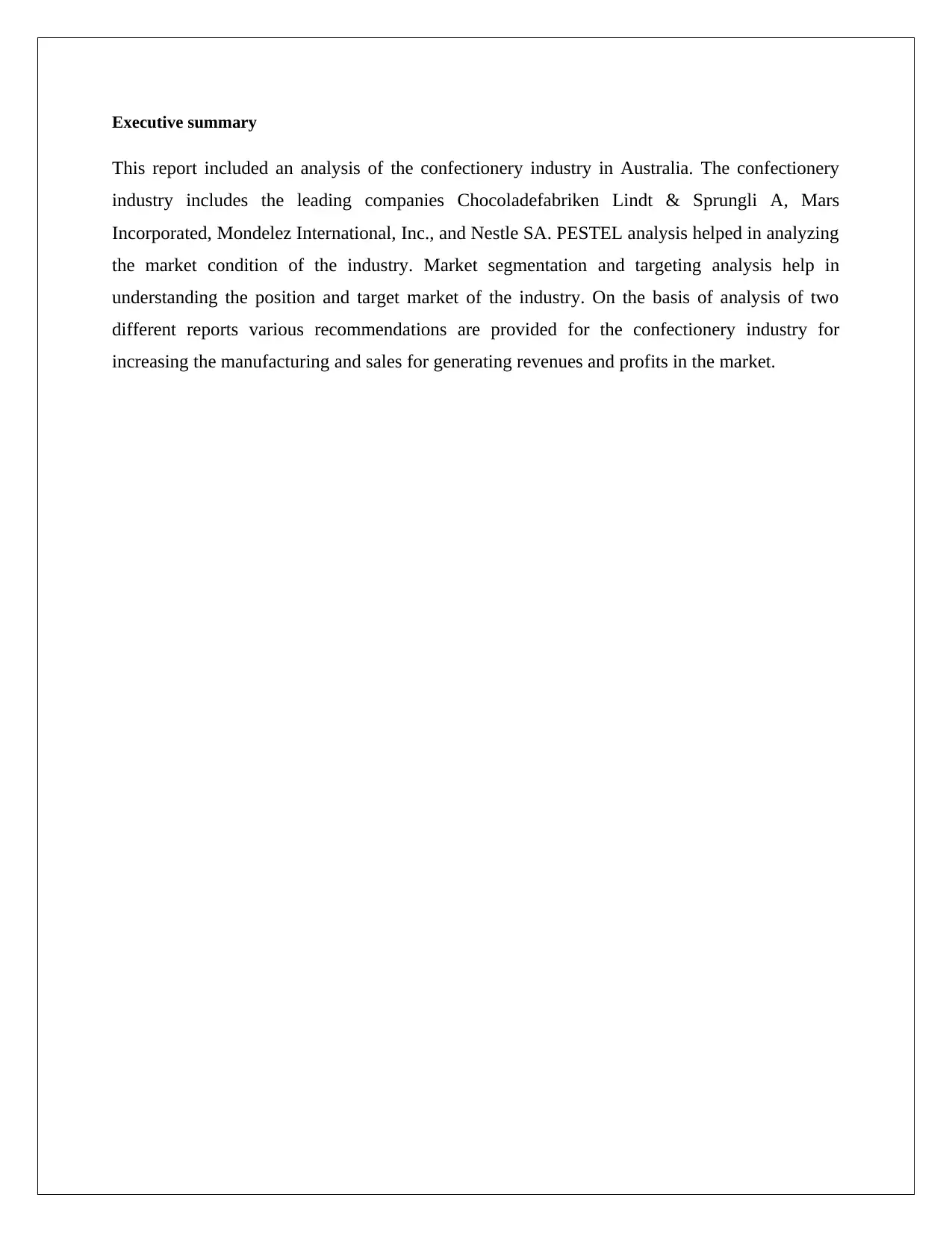
Executive summary
This report included an analysis of the confectionery industry in Australia. The confectionery
industry includes the leading companies Chocoladefabriken Lindt & Sprungli A, Mars
Incorporated, Mondelez International, Inc., and Nestle SA. PESTEL analysis helped in analyzing
the market condition of the industry. Market segmentation and targeting analysis help in
understanding the position and target market of the industry. On the basis of analysis of two
different reports various recommendations are provided for the confectionery industry for
increasing the manufacturing and sales for generating revenues and profits in the market.
This report included an analysis of the confectionery industry in Australia. The confectionery
industry includes the leading companies Chocoladefabriken Lindt & Sprungli A, Mars
Incorporated, Mondelez International, Inc., and Nestle SA. PESTEL analysis helped in analyzing
the market condition of the industry. Market segmentation and targeting analysis help in
understanding the position and target market of the industry. On the basis of analysis of two
different reports various recommendations are provided for the confectionery industry for
increasing the manufacturing and sales for generating revenues and profits in the market.
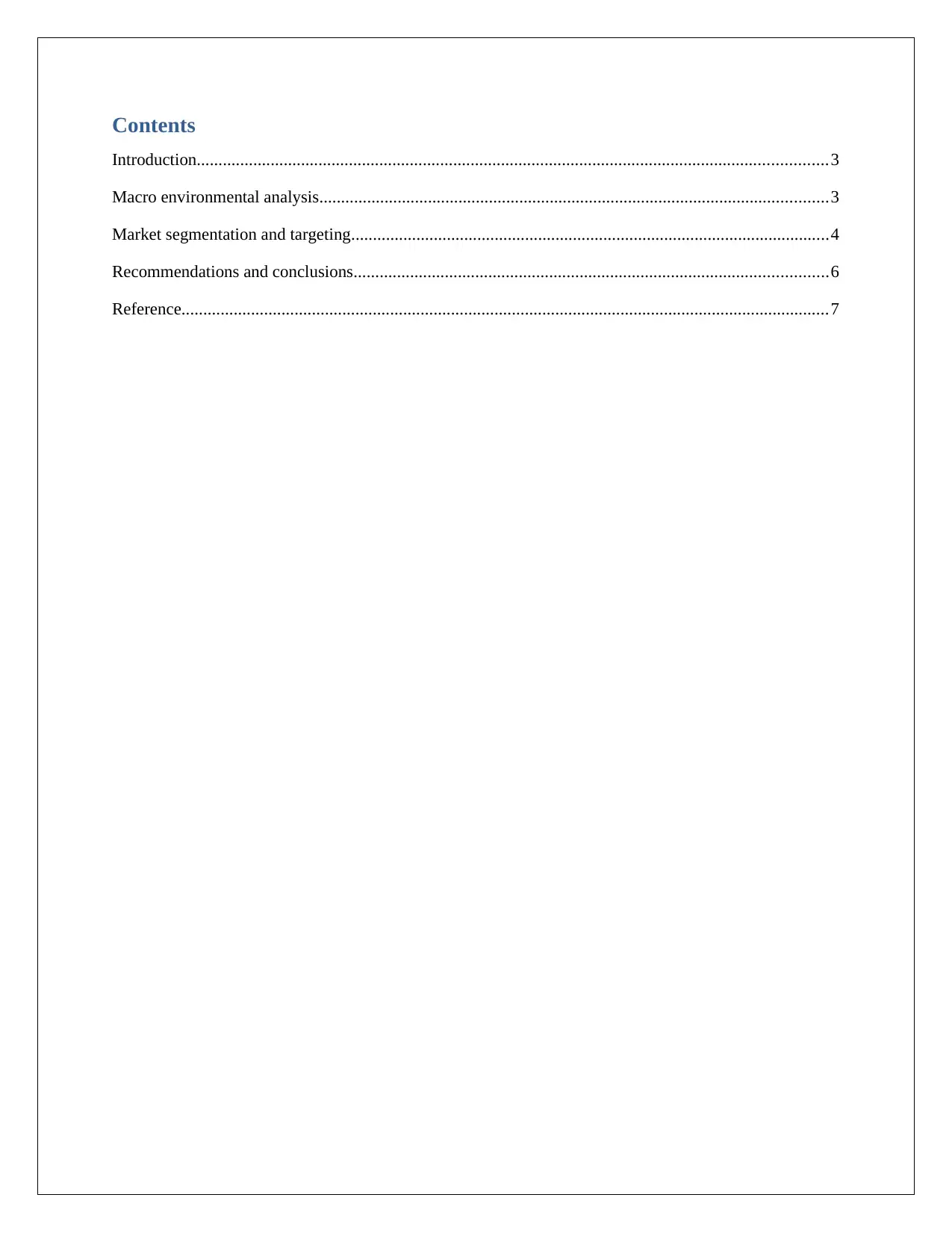
Contents
Introduction.................................................................................................................................................3
Macro environmental analysis.....................................................................................................................3
Market segmentation and targeting..............................................................................................................4
Recommendations and conclusions.............................................................................................................6
Reference.....................................................................................................................................................7
Introduction.................................................................................................................................................3
Macro environmental analysis.....................................................................................................................3
Market segmentation and targeting..............................................................................................................4
Recommendations and conclusions.............................................................................................................6
Reference.....................................................................................................................................................7
⊘ This is a preview!⊘
Do you want full access?
Subscribe today to unlock all pages.

Trusted by 1+ million students worldwide
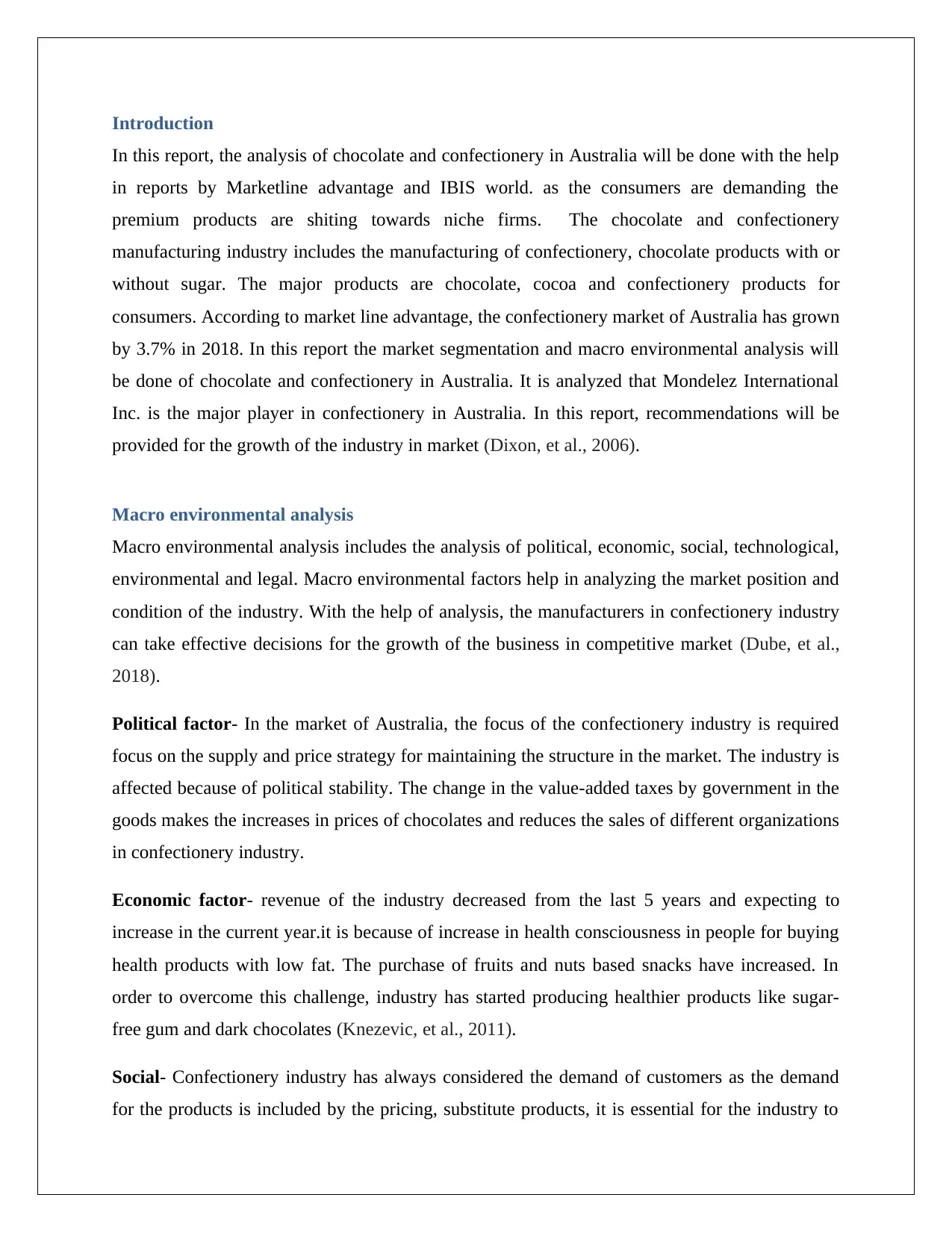
Introduction
In this report, the analysis of chocolate and confectionery in Australia will be done with the help
in reports by Marketline advantage and IBIS world. as the consumers are demanding the
premium products are shiting towards niche firms. The chocolate and confectionery
manufacturing industry includes the manufacturing of confectionery, chocolate products with or
without sugar. The major products are chocolate, cocoa and confectionery products for
consumers. According to market line advantage, the confectionery market of Australia has grown
by 3.7% in 2018. In this report the market segmentation and macro environmental analysis will
be done of chocolate and confectionery in Australia. It is analyzed that Mondelez International
Inc. is the major player in confectionery in Australia. In this report, recommendations will be
provided for the growth of the industry in market (Dixon, et al., 2006).
Macro environmental analysis
Macro environmental analysis includes the analysis of political, economic, social, technological,
environmental and legal. Macro environmental factors help in analyzing the market position and
condition of the industry. With the help of analysis, the manufacturers in confectionery industry
can take effective decisions for the growth of the business in competitive market (Dube, et al.,
2018).
Political factor- In the market of Australia, the focus of the confectionery industry is required
focus on the supply and price strategy for maintaining the structure in the market. The industry is
affected because of political stability. The change in the value-added taxes by government in the
goods makes the increases in prices of chocolates and reduces the sales of different organizations
in confectionery industry.
Economic factor- revenue of the industry decreased from the last 5 years and expecting to
increase in the current year.it is because of increase in health consciousness in people for buying
health products with low fat. The purchase of fruits and nuts based snacks have increased. In
order to overcome this challenge, industry has started producing healthier products like sugar-
free gum and dark chocolates (Knezevic, et al., 2011).
Social- Confectionery industry has always considered the demand of customers as the demand
for the products is included by the pricing, substitute products, it is essential for the industry to
In this report, the analysis of chocolate and confectionery in Australia will be done with the help
in reports by Marketline advantage and IBIS world. as the consumers are demanding the
premium products are shiting towards niche firms. The chocolate and confectionery
manufacturing industry includes the manufacturing of confectionery, chocolate products with or
without sugar. The major products are chocolate, cocoa and confectionery products for
consumers. According to market line advantage, the confectionery market of Australia has grown
by 3.7% in 2018. In this report the market segmentation and macro environmental analysis will
be done of chocolate and confectionery in Australia. It is analyzed that Mondelez International
Inc. is the major player in confectionery in Australia. In this report, recommendations will be
provided for the growth of the industry in market (Dixon, et al., 2006).
Macro environmental analysis
Macro environmental analysis includes the analysis of political, economic, social, technological,
environmental and legal. Macro environmental factors help in analyzing the market position and
condition of the industry. With the help of analysis, the manufacturers in confectionery industry
can take effective decisions for the growth of the business in competitive market (Dube, et al.,
2018).
Political factor- In the market of Australia, the focus of the confectionery industry is required
focus on the supply and price strategy for maintaining the structure in the market. The industry is
affected because of political stability. The change in the value-added taxes by government in the
goods makes the increases in prices of chocolates and reduces the sales of different organizations
in confectionery industry.
Economic factor- revenue of the industry decreased from the last 5 years and expecting to
increase in the current year.it is because of increase in health consciousness in people for buying
health products with low fat. The purchase of fruits and nuts based snacks have increased. In
order to overcome this challenge, industry has started producing healthier products like sugar-
free gum and dark chocolates (Knezevic, et al., 2011).
Social- Confectionery industry has always considered the demand of customers as the demand
for the products is included by the pricing, substitute products, it is essential for the industry to
Paraphrase This Document
Need a fresh take? Get an instant paraphrase of this document with our AI Paraphraser
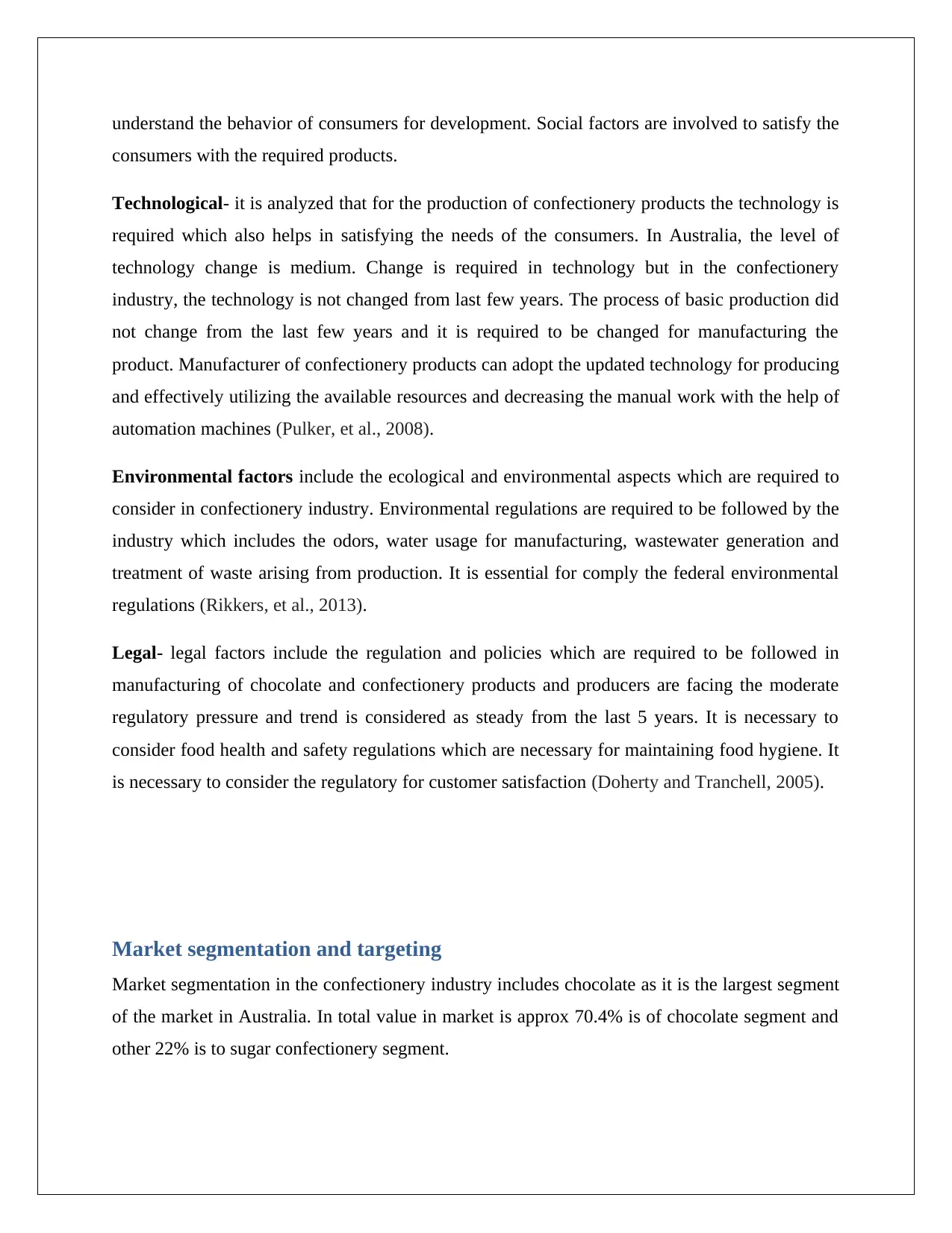
understand the behavior of consumers for development. Social factors are involved to satisfy the
consumers with the required products.
Technological- it is analyzed that for the production of confectionery products the technology is
required which also helps in satisfying the needs of the consumers. In Australia, the level of
technology change is medium. Change is required in technology but in the confectionery
industry, the technology is not changed from last few years. The process of basic production did
not change from the last few years and it is required to be changed for manufacturing the
product. Manufacturer of confectionery products can adopt the updated technology for producing
and effectively utilizing the available resources and decreasing the manual work with the help of
automation machines (Pulker, et al., 2008).
Environmental factors include the ecological and environmental aspects which are required to
consider in confectionery industry. Environmental regulations are required to be followed by the
industry which includes the odors, water usage for manufacturing, wastewater generation and
treatment of waste arising from production. It is essential for comply the federal environmental
regulations (Rikkers, et al., 2013).
Legal- legal factors include the regulation and policies which are required to be followed in
manufacturing of chocolate and confectionery products and producers are facing the moderate
regulatory pressure and trend is considered as steady from the last 5 years. It is necessary to
consider food health and safety regulations which are necessary for maintaining food hygiene. It
is necessary to consider the regulatory for customer satisfaction (Doherty and Tranchell, 2005).
Market segmentation and targeting
Market segmentation in the confectionery industry includes chocolate as it is the largest segment
of the market in Australia. In total value in market is approx 70.4% is of chocolate segment and
other 22% is to sugar confectionery segment.
consumers with the required products.
Technological- it is analyzed that for the production of confectionery products the technology is
required which also helps in satisfying the needs of the consumers. In Australia, the level of
technology change is medium. Change is required in technology but in the confectionery
industry, the technology is not changed from last few years. The process of basic production did
not change from the last few years and it is required to be changed for manufacturing the
product. Manufacturer of confectionery products can adopt the updated technology for producing
and effectively utilizing the available resources and decreasing the manual work with the help of
automation machines (Pulker, et al., 2008).
Environmental factors include the ecological and environmental aspects which are required to
consider in confectionery industry. Environmental regulations are required to be followed by the
industry which includes the odors, water usage for manufacturing, wastewater generation and
treatment of waste arising from production. It is essential for comply the federal environmental
regulations (Rikkers, et al., 2013).
Legal- legal factors include the regulation and policies which are required to be followed in
manufacturing of chocolate and confectionery products and producers are facing the moderate
regulatory pressure and trend is considered as steady from the last 5 years. It is necessary to
consider food health and safety regulations which are necessary for maintaining food hygiene. It
is necessary to consider the regulatory for customer satisfaction (Doherty and Tranchell, 2005).
Market segmentation and targeting
Market segmentation in the confectionery industry includes chocolate as it is the largest segment
of the market in Australia. In total value in market is approx 70.4% is of chocolate segment and
other 22% is to sugar confectionery segment.
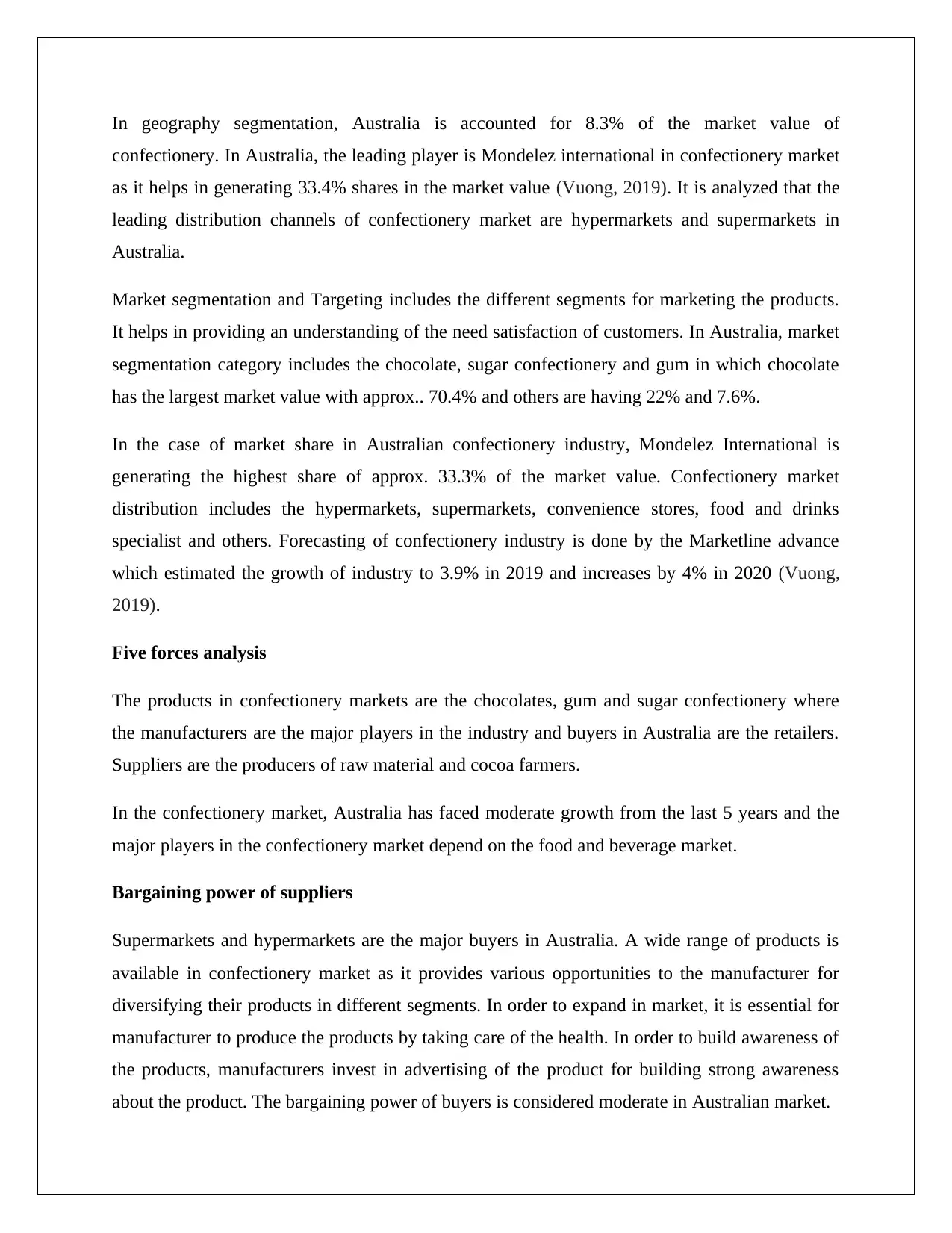
In geography segmentation, Australia is accounted for 8.3% of the market value of
confectionery. In Australia, the leading player is Mondelez international in confectionery market
as it helps in generating 33.4% shares in the market value (Vuong, 2019). It is analyzed that the
leading distribution channels of confectionery market are hypermarkets and supermarkets in
Australia.
Market segmentation and Targeting includes the different segments for marketing the products.
It helps in providing an understanding of the need satisfaction of customers. In Australia, market
segmentation category includes the chocolate, sugar confectionery and gum in which chocolate
has the largest market value with approx.. 70.4% and others are having 22% and 7.6%.
In the case of market share in Australian confectionery industry, Mondelez International is
generating the highest share of approx. 33.3% of the market value. Confectionery market
distribution includes the hypermarkets, supermarkets, convenience stores, food and drinks
specialist and others. Forecasting of confectionery industry is done by the Marketline advance
which estimated the growth of industry to 3.9% in 2019 and increases by 4% in 2020 (Vuong,
2019).
Five forces analysis
The products in confectionery markets are the chocolates, gum and sugar confectionery where
the manufacturers are the major players in the industry and buyers in Australia are the retailers.
Suppliers are the producers of raw material and cocoa farmers.
In the confectionery market, Australia has faced moderate growth from the last 5 years and the
major players in the confectionery market depend on the food and beverage market.
Bargaining power of suppliers
Supermarkets and hypermarkets are the major buyers in Australia. A wide range of products is
available in confectionery market as it provides various opportunities to the manufacturer for
diversifying their products in different segments. In order to expand in market, it is essential for
manufacturer to produce the products by taking care of the health. In order to build awareness of
the products, manufacturers invest in advertising of the product for building strong awareness
about the product. The bargaining power of buyers is considered moderate in Australian market.
confectionery. In Australia, the leading player is Mondelez international in confectionery market
as it helps in generating 33.4% shares in the market value (Vuong, 2019). It is analyzed that the
leading distribution channels of confectionery market are hypermarkets and supermarkets in
Australia.
Market segmentation and Targeting includes the different segments for marketing the products.
It helps in providing an understanding of the need satisfaction of customers. In Australia, market
segmentation category includes the chocolate, sugar confectionery and gum in which chocolate
has the largest market value with approx.. 70.4% and others are having 22% and 7.6%.
In the case of market share in Australian confectionery industry, Mondelez International is
generating the highest share of approx. 33.3% of the market value. Confectionery market
distribution includes the hypermarkets, supermarkets, convenience stores, food and drinks
specialist and others. Forecasting of confectionery industry is done by the Marketline advance
which estimated the growth of industry to 3.9% in 2019 and increases by 4% in 2020 (Vuong,
2019).
Five forces analysis
The products in confectionery markets are the chocolates, gum and sugar confectionery where
the manufacturers are the major players in the industry and buyers in Australia are the retailers.
Suppliers are the producers of raw material and cocoa farmers.
In the confectionery market, Australia has faced moderate growth from the last 5 years and the
major players in the confectionery market depend on the food and beverage market.
Bargaining power of suppliers
Supermarkets and hypermarkets are the major buyers in Australia. A wide range of products is
available in confectionery market as it provides various opportunities to the manufacturer for
diversifying their products in different segments. In order to expand in market, it is essential for
manufacturer to produce the products by taking care of the health. In order to build awareness of
the products, manufacturers invest in advertising of the product for building strong awareness
about the product. The bargaining power of buyers is considered moderate in Australian market.
⊘ This is a preview!⊘
Do you want full access?
Subscribe today to unlock all pages.

Trusted by 1+ million students worldwide
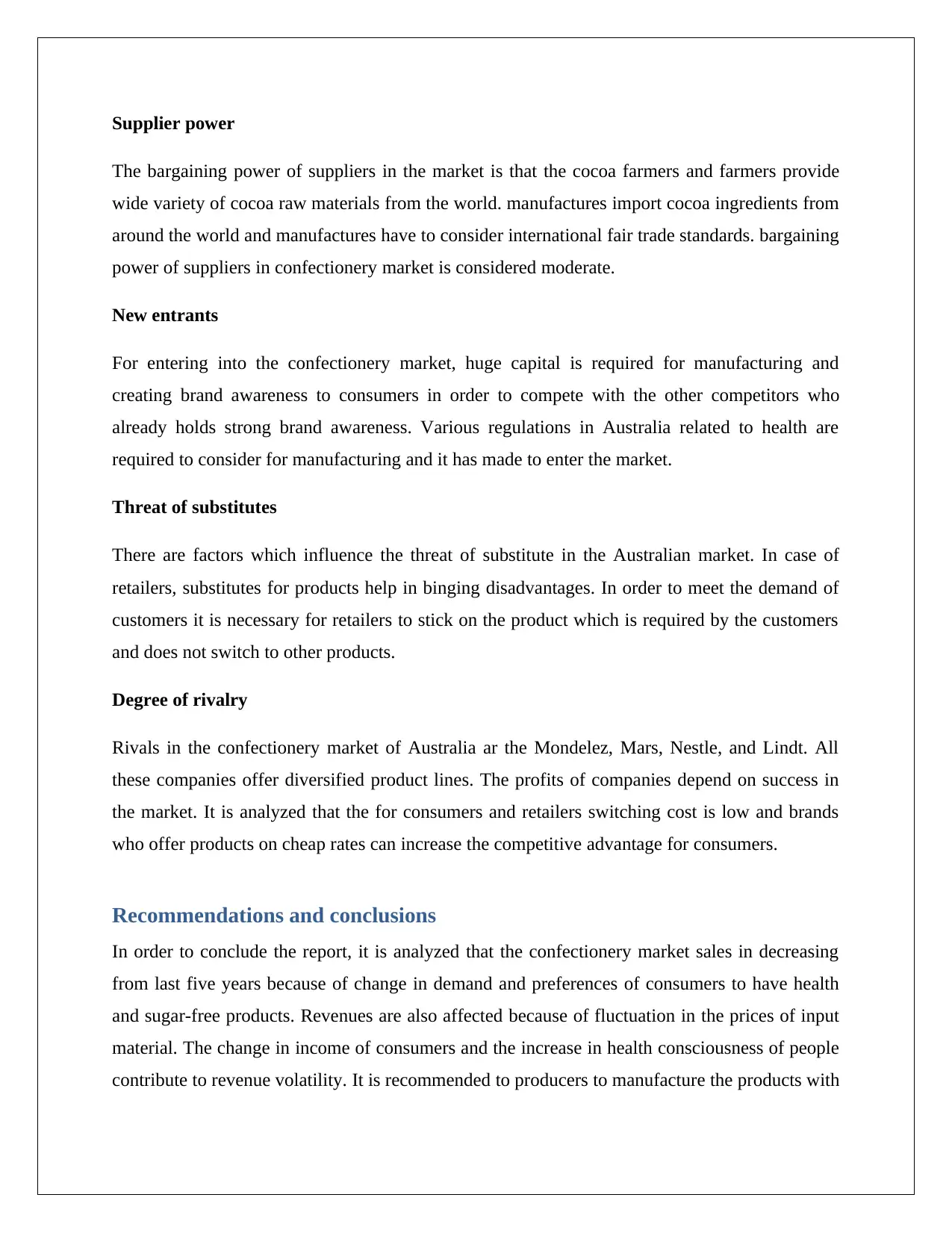
Supplier power
The bargaining power of suppliers in the market is that the cocoa farmers and farmers provide
wide variety of cocoa raw materials from the world. manufactures import cocoa ingredients from
around the world and manufactures have to consider international fair trade standards. bargaining
power of suppliers in confectionery market is considered moderate.
New entrants
For entering into the confectionery market, huge capital is required for manufacturing and
creating brand awareness to consumers in order to compete with the other competitors who
already holds strong brand awareness. Various regulations in Australia related to health are
required to consider for manufacturing and it has made to enter the market.
Threat of substitutes
There are factors which influence the threat of substitute in the Australian market. In case of
retailers, substitutes for products help in binging disadvantages. In order to meet the demand of
customers it is necessary for retailers to stick on the product which is required by the customers
and does not switch to other products.
Degree of rivalry
Rivals in the confectionery market of Australia ar the Mondelez, Mars, Nestle, and Lindt. All
these companies offer diversified product lines. The profits of companies depend on success in
the market. It is analyzed that the for consumers and retailers switching cost is low and brands
who offer products on cheap rates can increase the competitive advantage for consumers.
Recommendations and conclusions
In order to conclude the report, it is analyzed that the confectionery market sales in decreasing
from last five years because of change in demand and preferences of consumers to have health
and sugar-free products. Revenues are also affected because of fluctuation in the prices of input
material. The change in income of consumers and the increase in health consciousness of people
contribute to revenue volatility. It is recommended to producers to manufacture the products with
The bargaining power of suppliers in the market is that the cocoa farmers and farmers provide
wide variety of cocoa raw materials from the world. manufactures import cocoa ingredients from
around the world and manufactures have to consider international fair trade standards. bargaining
power of suppliers in confectionery market is considered moderate.
New entrants
For entering into the confectionery market, huge capital is required for manufacturing and
creating brand awareness to consumers in order to compete with the other competitors who
already holds strong brand awareness. Various regulations in Australia related to health are
required to consider for manufacturing and it has made to enter the market.
Threat of substitutes
There are factors which influence the threat of substitute in the Australian market. In case of
retailers, substitutes for products help in binging disadvantages. In order to meet the demand of
customers it is necessary for retailers to stick on the product which is required by the customers
and does not switch to other products.
Degree of rivalry
Rivals in the confectionery market of Australia ar the Mondelez, Mars, Nestle, and Lindt. All
these companies offer diversified product lines. The profits of companies depend on success in
the market. It is analyzed that the for consumers and retailers switching cost is low and brands
who offer products on cheap rates can increase the competitive advantage for consumers.
Recommendations and conclusions
In order to conclude the report, it is analyzed that the confectionery market sales in decreasing
from last five years because of change in demand and preferences of consumers to have health
and sugar-free products. Revenues are also affected because of fluctuation in the prices of input
material. The change in income of consumers and the increase in health consciousness of people
contribute to revenue volatility. It is recommended to producers to manufacture the products with
Paraphrase This Document
Need a fresh take? Get an instant paraphrase of this document with our AI Paraphraser
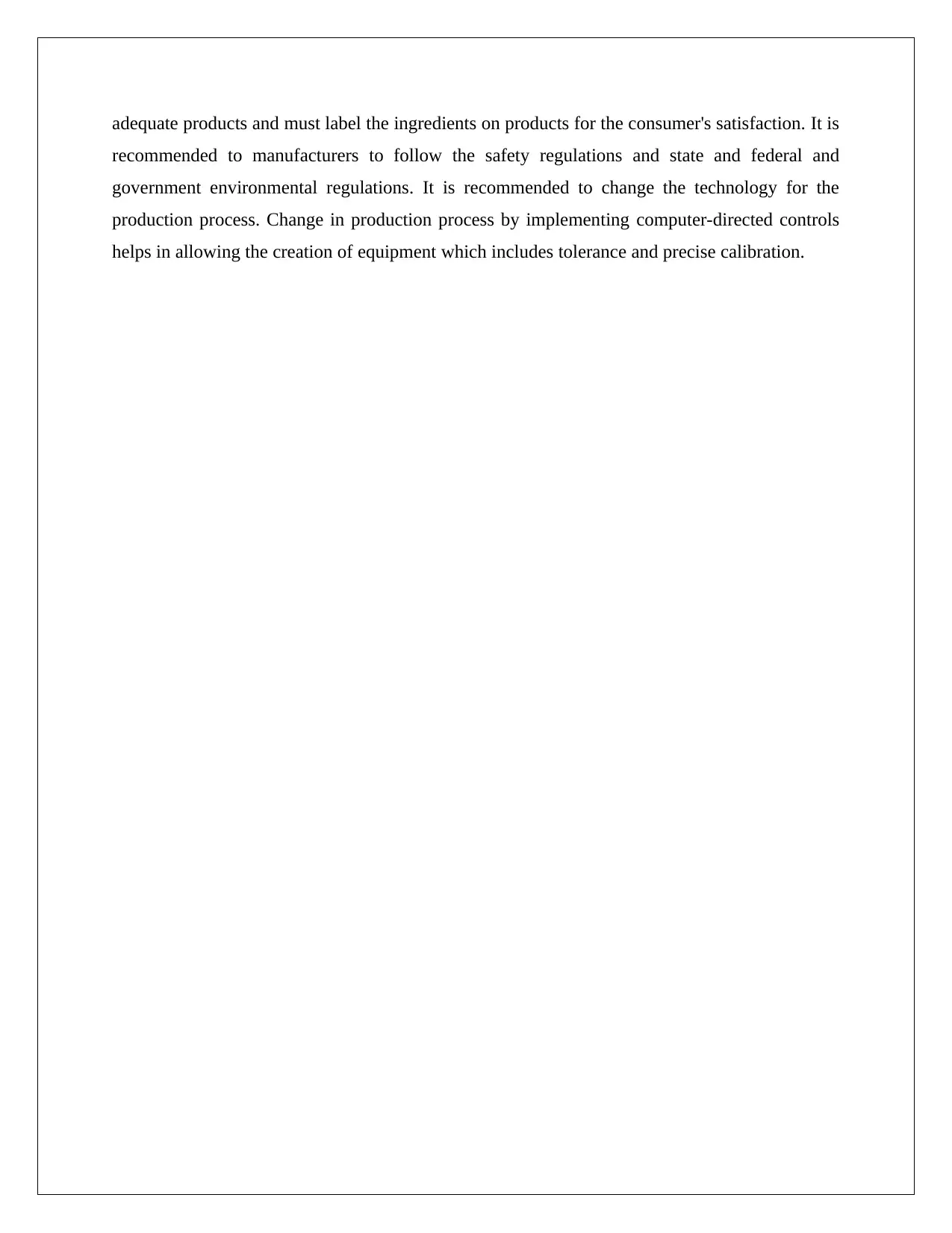
adequate products and must label the ingredients on products for the consumer's satisfaction. It is
recommended to manufacturers to follow the safety regulations and state and federal and
government environmental regulations. It is recommended to change the technology for the
production process. Change in production process by implementing computer-directed controls
helps in allowing the creation of equipment which includes tolerance and precise calibration.
recommended to manufacturers to follow the safety regulations and state and federal and
government environmental regulations. It is recommended to change the technology for the
production process. Change in production process by implementing computer-directed controls
helps in allowing the creation of equipment which includes tolerance and precise calibration.
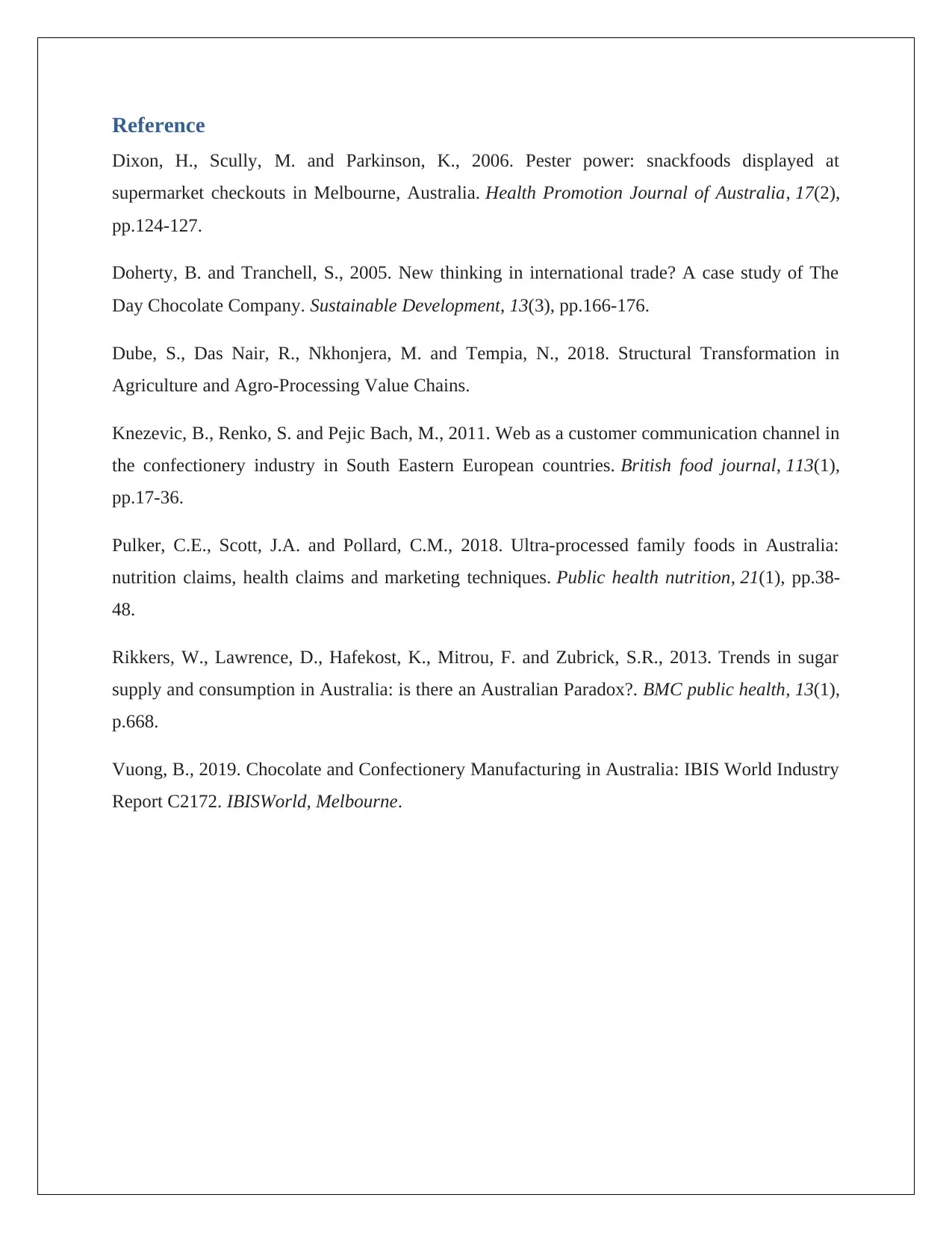
Reference
Dixon, H., Scully, M. and Parkinson, K., 2006. Pester power: snackfoods displayed at
supermarket checkouts in Melbourne, Australia. Health Promotion Journal of Australia, 17(2),
pp.124-127.
Doherty, B. and Tranchell, S., 2005. New thinking in international trade? A case study of The
Day Chocolate Company. Sustainable Development, 13(3), pp.166-176.
Dube, S., Das Nair, R., Nkhonjera, M. and Tempia, N., 2018. Structural Transformation in
Agriculture and Agro-Processing Value Chains.
Knezevic, B., Renko, S. and Pejic Bach, M., 2011. Web as a customer communication channel in
the confectionery industry in South Eastern European countries. British food journal, 113(1),
pp.17-36.
Pulker, C.E., Scott, J.A. and Pollard, C.M., 2018. Ultra-processed family foods in Australia:
nutrition claims, health claims and marketing techniques. Public health nutrition, 21(1), pp.38-
48.
Rikkers, W., Lawrence, D., Hafekost, K., Mitrou, F. and Zubrick, S.R., 2013. Trends in sugar
supply and consumption in Australia: is there an Australian Paradox?. BMC public health, 13(1),
p.668.
Vuong, B., 2019. Chocolate and Confectionery Manufacturing in Australia: IBIS World Industry
Report C2172. IBISWorld, Melbourne.
Dixon, H., Scully, M. and Parkinson, K., 2006. Pester power: snackfoods displayed at
supermarket checkouts in Melbourne, Australia. Health Promotion Journal of Australia, 17(2),
pp.124-127.
Doherty, B. and Tranchell, S., 2005. New thinking in international trade? A case study of The
Day Chocolate Company. Sustainable Development, 13(3), pp.166-176.
Dube, S., Das Nair, R., Nkhonjera, M. and Tempia, N., 2018. Structural Transformation in
Agriculture and Agro-Processing Value Chains.
Knezevic, B., Renko, S. and Pejic Bach, M., 2011. Web as a customer communication channel in
the confectionery industry in South Eastern European countries. British food journal, 113(1),
pp.17-36.
Pulker, C.E., Scott, J.A. and Pollard, C.M., 2018. Ultra-processed family foods in Australia:
nutrition claims, health claims and marketing techniques. Public health nutrition, 21(1), pp.38-
48.
Rikkers, W., Lawrence, D., Hafekost, K., Mitrou, F. and Zubrick, S.R., 2013. Trends in sugar
supply and consumption in Australia: is there an Australian Paradox?. BMC public health, 13(1),
p.668.
Vuong, B., 2019. Chocolate and Confectionery Manufacturing in Australia: IBIS World Industry
Report C2172. IBISWorld, Melbourne.
⊘ This is a preview!⊘
Do you want full access?
Subscribe today to unlock all pages.

Trusted by 1+ million students worldwide
1 out of 9
Related Documents
Your All-in-One AI-Powered Toolkit for Academic Success.
+13062052269
info@desklib.com
Available 24*7 on WhatsApp / Email
![[object Object]](/_next/static/media/star-bottom.7253800d.svg)
Unlock your academic potential
Copyright © 2020–2025 A2Z Services. All Rights Reserved. Developed and managed by ZUCOL.





